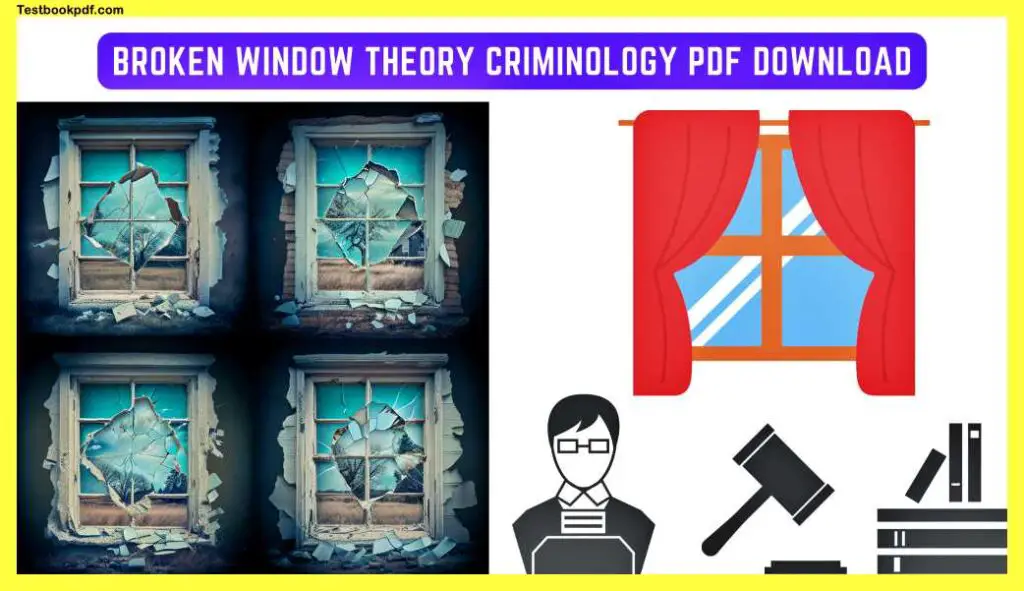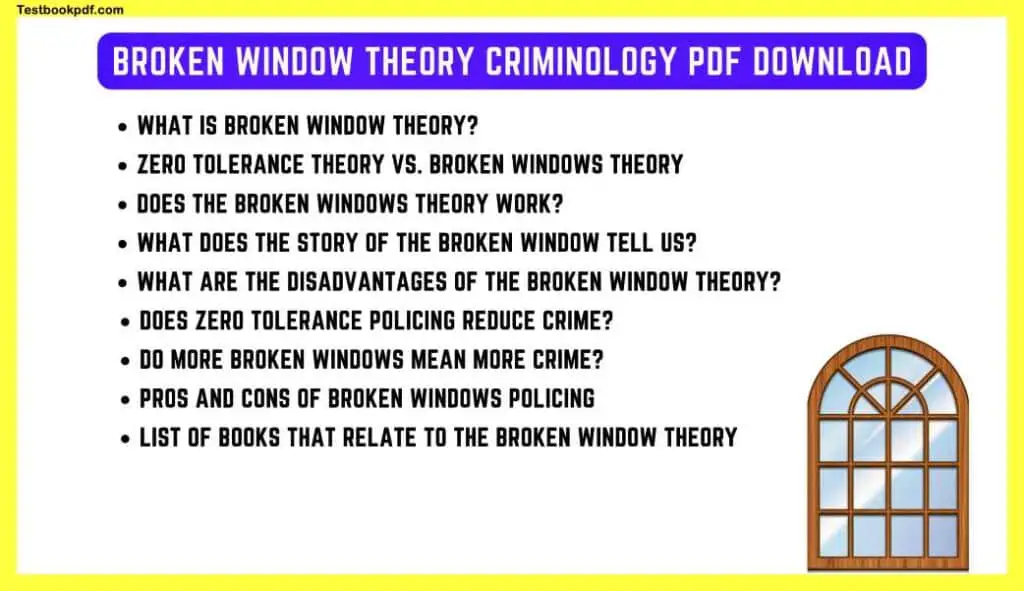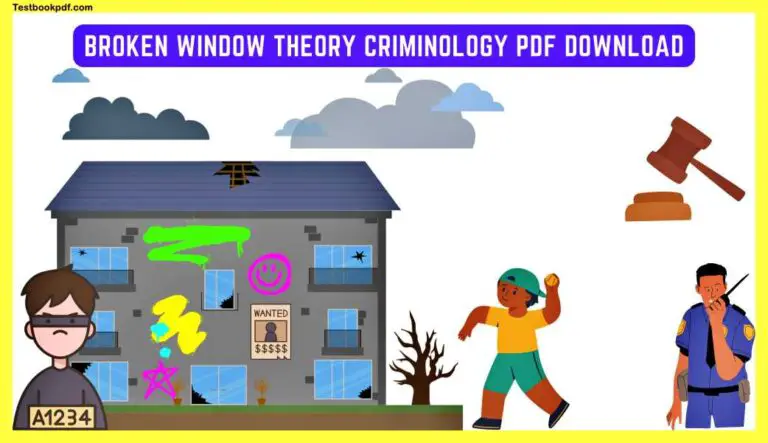Broken Window Theory Criminology Pdf Download
Today in this article we will talk about the Broken Window Theory Criminology Pdf Download, which is a concept in criminology that suggests that small acts of neglect or disorder in a community can eventually lead to more serious crime and social problems.
What is Broken Window Theory?
The Broken Window Theory is a concept in psychology that suggests that small acts of neglect or disorder in a community can eventually lead to more serious crime and social problems. The theory was first introduced by James Q. Wilson and George Kelling in a 1982 article published in the Atlantic Monthly, and it has been widely influential in the field of criminology and the study of urban decay.
According to the Broken Window Theory, the presence of broken windows or other visible signs of neglect in a community can create a sense of disorder and invite more serious crime. This is because these signs of neglect can be interpreted as a lack of social norms or a lack of community pride, which can lead individuals to feel less invested in their community and less likely to report or intervene in criminal activity.
For example, if a community has many broken windows or abandoned buildings, it may be perceived as a neglected or uncared-for place. This can create a sense of social disarray and a perception that there is a lack of social control, which can in turn lead to more serious crimes being committed. On the other hand, a community that is well-maintained and has a strong sense of community pride is likely to be perceived as safer and more inviting, which can help to deter crime.
In practice, the Broken Window Theory has been used to inform policies and programs aimed at crime prevention and community development, such as the “zero tolerance” policing strategy that was popularized in the 1990s. While the effectiveness of these strategies has been the subject of debate, the Broken Window Theory continues to be an influential concept in the study of crime and its potential root causes.
Another example of the Broken Window Theory in action might be a neighborhood with a high number of graffiti-covered buildings or streets. Some may interpret this visible sign of neglect and disorder as a lack of community pride or a lack of social norms, which can create a perception that the area is unsafe or unlivable. As a result, individuals may be less likely to report or intervene in criminal activity, and the community may be more vulnerable to more serious crimes being committed.
On the other hand, a community that takes steps to address graffiti or other visible signs of neglect may be perceived as more orderly and well-maintained, which can help to deter crime and promote a sense of community pride. This could involve initiatives such as graffiti removal programs or community clean-up efforts, which can help to create a more positive and inviting environment for residents and visitors.
Overall, the Broken Window Theory highlights the importance of addressing small acts of neglect or disorder in order to prevent larger problems from developing in a community. By maintaining social norms and addressing visible signs of neglect, communities can create safer and more cohesive environments for all residents.
Does the broken windows theory work?
The effectiveness of the Broken Window Theory in reducing crime rates has been the subject of debate among criminologists and policymakers. While some research has suggested that the theory may be effective in reducing certain types of crime, such as minor offenses and quality-of-life crimes, other studies have found mixed or limited evidence for its effectiveness.
One of the main criticisms of the Broken Window Theory is that it does not adequately account for the complex and multifaceted nature of crime and its root causes. While the theory suggests that addressing small acts of neglect or disorder can help to prevent more serious crimes from occurring, it does not fully consider the social and economic factors that may contribute to crime, such as poverty, inequality, and lack of access to education and job opportunities.
Additionally, some research has suggested that specific crime prevention strategies based on the Broken Window Theory, such as zero-tolerance policing, may have unintended consequences, such as disproportionately impacting marginalized communities or leading to increased police aggression.
Overall, while the Broken Window Theory may be effective in reducing certain types of crime, it is important to consider its limitations and to take a holistic approach to crime prevention that considers the broader social and economic factors that may contribute to crime.

What does the story of the broken window tell us?
The story of the broken window, as it is often told in the context of the Broken Window Theory, suggests that small acts of neglect or disorder in a community can eventually lead to more serious crime and social problems. The theory was first introduced by James Q. Wilson and George Kelling in a 1982 article published in the Atlantic Monthly, and it has been widely influential in the field of criminology and the study of urban decay.
According to the Broken Window Theory, the presence of broken windows or other visible signs of neglect in a community can create a sense of disorder and invite more serious crime. This is because these signs of neglect can be interpreted as a lack of social norms or a lack of community pride, which can lead individuals to feel less invested in their community and less likely to report or intervene in criminal activity.
The story of the broken window is often used to illustrate the idea that small acts of neglect or disorder can have a cascading effect, leading to more serious problems in a community over time. This is because these small acts of neglect can create a sense of social disarray and a perception that there is a lack of social control, which can in turn lead to more serious crimes being committed.
Overall, the story of the broken window suggests that addressing small acts of neglect or disorder is important in order to prevent larger problems from developing in a community. By maintaining social norms and addressing visible signs of neglect, communities can create safer and more cohesive environments for all residents.
What are the disadvantages of the broken window theory?
There are several criticisms of the Broken Window Theory that highlight some of the potential disadvantages of this concept. These criticisms include:
- Limited effectiveness: Some research has found limited or mixed evidence for the effectiveness of the Broken Window Theory in reducing crime rates. While the theory may be effective in reducing certain types of crime, such as minor offenses and quality-of-life crimes, it may not be as effective in reducing more serious crimes.
- Unintended consequences: Certain crime prevention strategies based on the Broken Window Theory, such as zero-tolerance policing, may have unintended consequences, such as disproportionately impacting marginalized communities or leading to increased police aggression.
- Limited scope: The Broken Window Theory does not adequately account for the complex and multifaceted nature of crime and its root causes. It does not fully consider the social and economic factors that may contribute to crime, such as poverty, inequality, and lack of access to education and job opportunities.
- Misuse of resources: Some critics argue that crime prevention strategies based on the Broken Window Theory may be a misuse of resources, as they may be focused on addressing minor offenses and quality-of-life crimes rather than more serious or violent crimes.
- Negative impact on community relations: The emphasis on cracking down on minor offenses and infractions as a means of preventing more serious crimes may create negative relationships between law enforcement and community members, particularly in marginalized communities.
Overall, while the Broken Window Theory may have some potential advantages in terms of reducing certain types of crime, it is important to consider its limitations and to take a holistic approach to crime prevention that considers the broader social and economic factors that may contribute to crime.
Does zero tolerance policing reduce crime?
Zero tolerance policing is a crime prevention strategy based on the Broken Window Theory, which suggests that cracking down on minor offenses and infractions can help to deter more serious crimes. This approach involves strictly enforcing laws and regulations, regardless of the circumstances, in an effort to create a sense of order and control in a community.
The effectiveness of zero-tolerance policing in reducing crime rates has been the subject of debate among criminologists and policymakers. While some research has suggested that zero-tolerance policing may be effective in reducing certain types of crime, such as minor offenses and quality-of-life crimes, other studies have found mixed or limited evidence for its effectiveness.
Additionally, zero-tolerance policing has been criticized for having unintended consequences, such as disproportionately impacting marginalized communities or leading to increased police aggression. Some research has also suggested that zero-tolerance policing may be a misuse of resources, as it may be focused on addressing minor offenses and quality-of-life crimes rather than more serious or violent crimes.
Overall, while zero tolerance policing may have some potential advantages in terms of reducing certain types of crime, it is important to consider its limitations and to take a holistic approach to crime prevention that considers the broader social and economic factors that may contribute to crime.
Do more broken windows mean more crime?
According to the Broken Window Theory, the presence of broken windows or other visible signs of neglect in a community can create a sense of disorder and invite more serious crime. This is because these signs of neglect can be interpreted as a lack of social norms or a lack of community pride, which can lead individuals to feel less invested in their community and less likely to report or intervene in criminal activity.
In other words, the Broken Window Theory suggests that small acts of neglect or disorder can have a cascading effect, leading to more serious problems in a community over time. This is because these small acts of neglect can create a sense of social disarray and a perception that there is a lack of social control, which can in turn lead to more serious crimes being committed.
While the Broken Window Theory suggests that more broken windows may be associated with more crime, it is important to note that the relationship between broken windows and crime is complex and multifaceted. There may be other factors at play, such as poverty, inequality, and lack of access to education and job opportunities, that also contribute to crime rates in a community.
Overall, while the presence of broken windows may be a contributing factor to crime, it is important to consider the broader social and economic context in which crime occurs in order to understand and address its root causes.

Pros and Cons of Broken Windows Policing
Broken windows policing is a crime prevention strategy based on the Broken Window Theory, which suggests that cracking down on minor offenses and infractions can help to deter more serious crimes. This approach involves strictly enforcing laws and regulations, regardless of the circumstances, in an effort to create a sense of order and control in a community.
Pros of broken windows policing:
- Reduction in certain types of crime: Some research has suggested that broken windows policing may be effective in reducing certain types of crime, such as minor offenses and quality-of-life crimes.
- Improvement in community perceptions of safety: Broken windows policing may lead to an improvement in community perceptions of safety, as it creates a sense of order and control in a community.
Cons of broken windows policing:
- Limited effectiveness in reducing more serious crimes: Some research has found limited or mixed evidence for the effectiveness of broken windows policing in reducing more serious crimes.
- Unintended consequences: Broken windows policing has been criticized for having unintended consequences, such as disproportionately impacting marginalized communities or leading to increased police aggression.
- Misuse of resources: Broken windows policing may be a misuse of resources, as it may be focused on addressing minor offenses and quality-of-life crimes rather than more serious or violent crimes.
- Negative impact on community relations: The emphasis on cracking down on minor offenses and infractions as a means of preventing more serious crimes may create negative relationships between law enforcement and community members, particularly in marginalized communities.
Overall, while broken-windows policing may have some potential advantages in terms of reducing certain types of crime, it is important to consider its limitations and take a holistic approach to crime prevention.
Zero Tolerance Theory vs. Broken Windows Theory
The Broken Window Theory and the Zero Tolerance Theory are both crime prevention approaches that have been influenced by the Broken Window Theory, a concept in psychology that suggests that small acts of neglect or disorder in a community can eventually lead to more serious crime and social problems. However, there are some key differences between these two theories.
The Broken Window Theory suggests that small acts of neglect or disorder, such as broken windows or graffiti, can create a sense of social disarray and a perception that there is a lack of social control, which can in turn lead to more serious crimes being committed. The theory suggests that addressing small acts of neglect or disorder is important in order to prevent larger problems from developing in a community.
The Zero Tolerance Theory, on the other hand, is a crime prevention strategy that is based on the idea of strictly enforcing laws and regulations, regardless of the circumstances, in an effort to create a sense of order and control in a community. This approach is often associated with broken windows policing, which involves cracking down on minor offenses and infractions as a means of deterring more serious crimes.
While both the Broken Window Theory and the Zero Tolerance Theory are focused on addressing small acts of neglect or disorder as a means of preventing more serious crimes, the Zero Tolerance Theory takes a more punitive approach, emphasizing strict enforcement of laws and regulations as a means of deterring crime. The Broken Window Theory, on the other hand, emphasizes the importance of addressing small acts of neglect or disorder in order to create a sense of social cohesion.
list of books that relate to the Broken Window Theory
Here is a list of books that relate to the Broken Window Theory:
- “The Broken Windows: The Police and Neighborhood Safety” by James Q. Wilson and George Kelling
- “Order Without Law: How Neighbors Settle Disputes” by Robert Ellickson
- “Fixing Broken Windows: Restoring Order and Reducing Crime in Our Communities” by George L. Kelling and Catherine M. Coles
- “Broken Windows: Policing, Crime, and Social Justice” edited by Peter K. Manning and Robert J. Sampson
- “Policing the Open Society” edited by David H. Bayley
- “The Social Order of the Underworld: How Prison Gangs Govern the American Penal System” by David Skarbek
- “The New Urban Crisis: How Our Cities Are Increasing Inequality, Deepening Segregation, and Failing the Middle Class—and What We Can Do About It” by Richard Florida
- “The Tipping Point: How Little Things Can Make a Big Difference” by Malcolm Gladwell
- “The Crime Drop in America” edited by Alfred Blumstein and Joel Wallman
- “The Death and Life of Great American Cities” by Jane Jacobs



